Matterhorn Gotthard Bahn
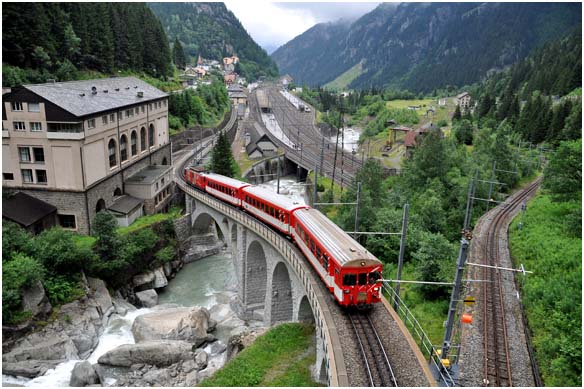
This Matterhorn Gotthard Bahn (MGB) train has just departed Göschenen station in the far distance and is now climbing the rack section leading to the Schöllenen Gorge. The several standard gauge tracks to the right of the train lead to the north portal of the Gotthard Tunnel located behind the trees.
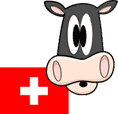  Switzerland Switzerland
This is my third article about Swiss railways in 2011. Check out the other two articles on the Rhätische Bahn (RhB) and the Dampfbahn Furka-Bergstrecke (DFB) located in the Slim Archive. For a very brief description of the country known as Switzerland click on the logo of the Swiss cow to the right.
 Matterhorn Gotthard Bahn (MGB) Matterhorn Gotthard Bahn (MGB)
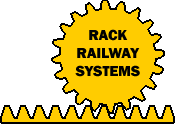 This private Swiss railway operates in the cantons of Wallis, Valais, Uri, and Graubünden. It may be best known because of the slowest express train in the world, the Glacier Express, than for all the local service it provides. Trains are pulled by electric locomotives that operate in both adhesion mode on regular metre gauge track and also on rack sections where the grades are too steep for adhesion operation. The main line runs northeast from Zermatt to Disentis where the railway connects with the Rhätische Bahn. This private Swiss railway operates in the cantons of Wallis, Valais, Uri, and Graubünden. It may be best known because of the slowest express train in the world, the Glacier Express, than for all the local service it provides. Trains are pulled by electric locomotives that operate in both adhesion mode on regular metre gauge track and also on rack sections where the grades are too steep for adhesion operation. The main line runs northeast from Zermatt to Disentis where the railway connects with the Rhätische Bahn.
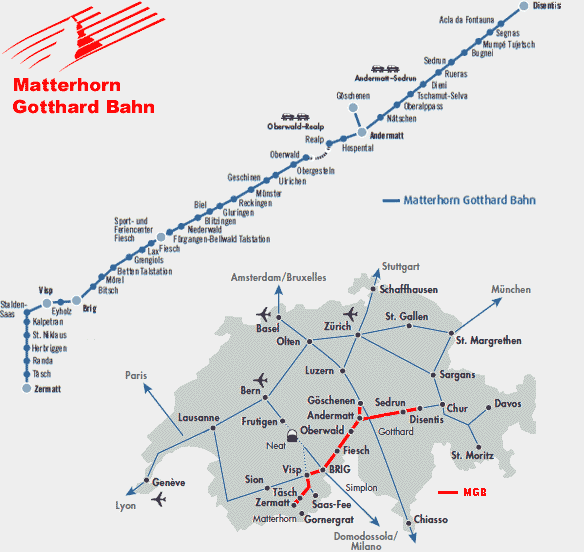
 Grade Chart Grade Chart
Here is the grade chart for the main line between Zermatt and Disentis.
 MGB History MGB History
Shortly after the first ascent of the Matterhorn by Edward Whymper in 1865 tourists began to flow into Zermatt. Access was by foot or on a mule which rapidly became unsuitable as the number of tourists grew. In 1888 the "Compagnie du Chemin de Fer de Viège à Zermatt" was founded to construct and operate a railway between Visp and Zermatt. Traffic began moving along the Visp Zermatt Bahn (VZ) by 1891 after the first train arrival. Tourism thrived until the outbreak of World War I. During the summer of 1914 there were twelve trains per day between Visp and Zermatt. This dropped to six then to only four by 1918. Between the two World Wars passenger traffic increased slowly until 1931 then levelled until the end of the second War.
At the outbreak of the First World War the Brig Furka Disentis Bahn (BFD) had managed to complete a route from Brig to Gletsch but by 1923 the railway was bankrupt. In 1925 the VZ took the initiative and purchased the line for 1.75 million francs. In that same year the Furka Oberalp Bahn (FO) was founded and by 1926 the whole FO line from Brig to Disentis was operational.
This left only a small gap between VZ in Visp and the FO in Brig. In 1930 the gap was closed giving a continuous narrow gauge route from Zermatt to Disentis over the VZ and FO. It was at this time the Glacier Express took advantage of the newly connected route and commenced operation from Zermatt to Saint Moritz over the Furka Pass next to the Rhone Glacier from whence it took its name.
It wasn't until 1962 the VZ was renamed the Brig Visp Zermatt Bahn (BVZ).
To continue the evolution the Matterhorn Gotthard Bahn (MGB) was formed in 2003 from the BVZ Zermatt Bahn (BVZ) and the Furka Oberalp Bahn (FO). Between Oberwald and Realp the route used to cross over Furka Pass. When the 15.34 kilometre (9.53 mile) long Furka Base Tunnel came into operation in 1982 the Furka Pass route was abandoned. Construction of this tunnel permitted year round operation of the Glacier Express. The steam powered Dampfbahn Furka-Bergstrecke (DFB) now operates over the previously abandoned Furka Pass route during the summer months.
(To learn more about the DFB visit the Slim Archive.)
East of Realp the MGB continues to Andermatt on the original FO line where it utilizes many switchbacks to climb up to the summit of Oberalp Pass. From the summit the line reaches eastward to Disentis and the junction with the Rhätische Bahn.
So far there's been no mention of the MGB's line from Andermatt north to Göschenen. This route, running through the Schöllenen Gorge, opened in 1917 as the Schöllenenbahn (SchB). The station in Göschenen is shared with the standard gauge SBB Gotthard line trains. The SchB was merged with the FO in 1961. Today's MGB operates local trains through the Schöllenen Gorge next to the Teufelsbrücke (Devil's Bridge).
 The Glacier Express The Glacier Express
 The Glacier Express operates over a route between Zermatt in the west of Switzerland and St. Moritz in the east. You may ride the trains in either direction. While the coaches and dining service cars travel the entire route the locomotives pulling the trains change at Disentis (dis-EN-tees). This is because two different railways operate the trains. On the western portion the Matterhorn Gotthard Bahn (MGB) pulls the cars while the eastern half of the route is operated by the Rhätische Bahn (RhB). MGB trains are pulled by rack and adhesion electric locomotives known as model HGe 4/4 II. They were built by SLM, (Schweizerische Lokomotiv und Maschinenfabrik or Swiss Locomotive and Machine Works) at Winterthur, Switzerland, from 1985 to 1990. These metre gauge locomotives are capable of both adhesion and rack operation on the steeper grades along the route. While on the move it's unnoticeable when the train engages a rack section without stopping. The entire journey from one end to the other takes 7 1/2 hours to traverse 291 bridges and 91 tunnels climbing to an elevation of 2,033 metres (6,670 feet) over the Oberalp Pass. The name "Express" is a tongue-in-cheek misnomer for the world's slowest fastest train. The Glacier Express operates over a route between Zermatt in the west of Switzerland and St. Moritz in the east. You may ride the trains in either direction. While the coaches and dining service cars travel the entire route the locomotives pulling the trains change at Disentis (dis-EN-tees). This is because two different railways operate the trains. On the western portion the Matterhorn Gotthard Bahn (MGB) pulls the cars while the eastern half of the route is operated by the Rhätische Bahn (RhB). MGB trains are pulled by rack and adhesion electric locomotives known as model HGe 4/4 II. They were built by SLM, (Schweizerische Lokomotiv und Maschinenfabrik or Swiss Locomotive and Machine Works) at Winterthur, Switzerland, from 1985 to 1990. These metre gauge locomotives are capable of both adhesion and rack operation on the steeper grades along the route. While on the move it's unnoticeable when the train engages a rack section without stopping. The entire journey from one end to the other takes 7 1/2 hours to traverse 291 bridges and 91 tunnels climbing to an elevation of 2,033 metres (6,670 feet) over the Oberalp Pass. The name "Express" is a tongue-in-cheek misnomer for the world's slowest fastest train.

 Engaging a Rack on the Move Engaging a Rack on the Move
 Wherever there's a track transition from adhesion running to rack operation there needs to be a device to enable a smooth transition. The drawing to the right is a modern SLM (Schweizerische Lokomotiv und Maschinenfabrik) bogie. Although not the same as those used on MGB locomotives (it contains an electro-magnetic rail brake) the principle of operation may be similar. Wherever there's a track transition from adhesion running to rack operation there needs to be a device to enable a smooth transition. The drawing to the right is a modern SLM (Schweizerische Lokomotiv und Maschinenfabrik) bogie. Although not the same as those used on MGB locomotives (it contains an electro-magnetic rail brake) the principle of operation may be similar.
This track device was photographed at the summit of the Oberalp Pass. I have been unable to find a technical explanation of how the device operates but believe this is the correct interpretation that follows. If you can provide a more accurate description or correct any errors please contact this web site.
The device is divided into three sections: The first is a smooth ramp made from a material that resembles rubber but appears much tougher so as to reduce wear. The second section, of about the same length, contains a series of, for lack of a better description, bumps. These are made of the same material as the ramp but are comprised of two rows offset like the teeth of an Abt rack section. The third section is a steel Abt rack section but with only 1 set of teeth. Near the end of this third section a normal two tooth Abt rack section is attached.
The way I see this working is the locomotives cog wheels on an approaching locomotive are disengaged by a clutch so they can rotate freely. As the moving locomotive passes over the first section of the device the cog wheels rub against the ramp surface causing them to rotate. Next they run over the bumpy section which would cause the cog wheels to align with the bumps. Next they strike the half Abt steel teeth and should be aligned by this time so as to mesh properly. Finally the full Abt rack is engaged. All this happens without slowing the locomotive. Once the locomotive is fully on the rack the clutch is then engaged so the traction motors can provide pulling power. The rack brake would also be effective at this point.
Because the ramp material and the bumpy section are made of material softer than the locomotive cog wheels most wear will occur on the track device rather than on the cog wheels. Close examination of the track device shows wear spots on the ramp, the first portion of the bumpy section, and the first few steel teeth of the half Abt rack section. The maintenance required to change out these track components would be less costly than replacing locomotive cog wheels.
 MGB Locomotives MGB Locomotives
The MGB operates several types of electric and some diesel locomotives. The majority of these locomotives were constructed by Schweizerische Lokomotiv und Maschinenfabrik (SLM) located in Winterthur which was founded in 1871. The following roster of MGB locomotives is incomplete as it does not include several diesel switchers in use throughout various parts of the system:
Deh 4/4 I
Built: 1972
Builder: SLM
Classification: Bo-Bo electric
Maximum Speed Adhesion: 60 kph (37.3 mph)
Maximum Speed Rack: 30 kph (18.6 mph)
Length: 16.9 m (55.4 feet)
Weight: 48 tons
Power: 11 Kv 16 2/3 Hz
|
Deh 4/4 II
Built: 1979-1984
Builder: SLM
Classification: Bo-Bo electric
Maximum Speed Adhesion: 60 kph (37.3 mph)
Maximum Speed Rack: 30 kph (18.6 mph)
Length: 15.5 m (50.9 feet)
Weight: 48.3 tons
Power: 11 Kv 16 2/3 Hz
|
HGe 4/4 I
Built: 1941-1956
Builder: SLM
Classification: Bo-Bo electric
Maximum Speed Adhesion: 55 kph (34.2 mph)
Maximum Speed Rack: 30 kph (18.6 mph)
Length: 14.12 m (46.3 feet)
Weight: 46 tons
Power: 11 Kv 16 2/3 Hz
|
HGe 4/4 II
Built: 1985-1990
Builder: SLM
Classification: Bo-Bo electric
Maximum Speed Adhesion: 100 kph (62.1 mph)
Maximum Speed Rack: ? kph (? mph)
Length: 14.8 m (48.6 feet)
Weight: 63 tons
Power: 11 Kv 16 2/3 Hz
|
Ge 4/4 III
Built: 1979
Builder: SLM
Classification: Bo-Bo electric
Maximum Speed Adhesion: 90 kph (55.9 mph)
Maximum Speed Rack: 56 kph (34.8 mph)
Length: 12.9 m (42.3 feet)
Weight: 50 tons
Power: 11 Kv 16 2/3 Hz
|
HGm 4/4
Built: 1968
Builder: SLM
Classification: Bo-Bo Diesel electric
Maximum Speed Adhesion: 65 kph (40.4 mph)
Maximum Speed Rack: ? kph (? mph)
Length: 13.54 m (44.4 feet)
Weight: 50.4 tons
Power: 2 Cummins diesels
|
ABt
Built: 1971
Builder: SIG
Classification: Cab Control Car
Maximum Speed Adhesion: 90 kph (55.9 mph)
Maximum Speed Rack: ? kph (? mph)
Length: 17.02 m (55.8 feet)
Weight: 14 tons
Power: Un-powered
|
BDt
Built: ?
Builder: ?
Classification: Cab Control Car
Maximum Speed Adhesion: ? kph (? mph)
Maximum Speed Rack: ? kph (? mph)
Length: ? m (? feet)
Weight: ? tons
Power: Un-powered
|
ABDeh 4/10
Built: 2007-2008
Builder: Stadler
Classification: 2 Bo-Bo electric
Maximum Speed Adhesion: 80 kph (49.7 mph)
Maximum Speed Rack: ? kph (? mph)
Length: 74.72 m (245.1 feet)
Weight: 95 tons
Power: 11 Kv 16 2/3 Hz
Note: These 3 car sets are named Komet.
|
|
SLM = Schweizerische Lokomotiv und Maschinenfabrik
SIG = Schweizerische Industrie Gesellschaft.
Stadler = Stadler Rail AG
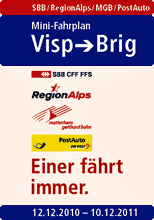  Mini-Timetable Visp Brig Mini-Timetable Visp Brig
This Mini-Fahrplan (Timetable) shows standard gauge SBB Alp Region trains, MGB narrow gauge trains, and PostAuto bus schedule between Visp and Brig from 12 Dec 2010 to 10 Dec 2011. Click on the image to view the complete Fahrplan.
 News Articles News Articles
12 Dec 2004 - MGB Adjusts Schedule
17 Feb 2006 - Goms is Accessible Again
30 Apr 2006 - Rail Gourmino Instead of Elvetino
12 Nov 2007 - Railway Bridge For Sale
16 Dec 2008 - Partial Relaxation in the Swiss Mountains
30 Nov 2009 - Wet Snow Avalanche Rips Oberalp Train
27 Jul 2010 - Lokführer (Engineer) Accelerated Strongly Into the Curve?
30 Jul 2010 - Driver Error to Blame for Glacier Express Crash
25 Nov 2010 - Glacier Express with Less Income
7 Sep 2011 - BVZ Holding Verifies Renewable Energy
 Autoverlad Furka Autoverlad Furka
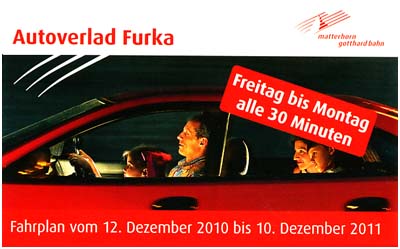
Click on the image above to view photos of the Autoverlad Furka (Furka Auto Transport) located at Realp. At Oberwald and Realp you can drive your car onto a covered flatcar for an approximate 15 minute ride through the Furka Base Tunnel to avoid driving over Furka Pass. During weekdays, between 06:00 and 22:30 hours, trains depart every 30 minutes. The cost per car, larger vehicles pay more to a maximum of 20 tons, is CHF25 ($30.50 as of July 2011) during summer months, and CHF30 ($36.60) in the winter.
 Associated Web Sites Associated Web Sites
Matterhorn Gotthard Bahn (MGB)
Glacier Express
Rhätische Bahn (RhB)
Dampfbahn Furka Bergstrecke (DFB)
Association Pro Salon
Stadler Rail
Rail Gourmino
Railfan Europe Net
Modell Bahnen
|